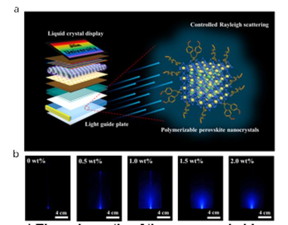Home > Press > Light guide plate based on perovskite nanocomposites
 |
| (a), The graphical abstract of the work: The PNCs/PS nanocomposite is fabricated through a two-type ligand strategy, which is proper to serve as LGP in LCD-related application based on the Rayleigh scattering behavior of the PNCs. (b), The function of LGP: When the blue laser light transports through the bulk nanocomposite with different doping content, the light and its surface output can be uniformized and enhanced.
CREDIT by Chongming Liu, Zhicheng Zhu, Kaibo Pan, Yuan Fu, Kai Zhang and Bai Yang |
Abstract:
The fact that nanoparticle and polymer hybrid materials can often combine the advantages of each has been demonstrated in several fields. Embedding PNCs into polymer is an effective strategy to enhance the PNCs stability and polymer can endow the PNCs with other positive effects based on different structure and functional groups. The uniform distribution of PNCs in polymer matrix is critical to the properties of the nanocomposites and the aggregation of PNCs induced by high surface energy has a severe influence on the performance of related applications. As such, the loading fraction is limited owing to the phase separation between PNCs and polymer. Chemical interaction between PNCs and polymer is necessary to suppress the phase separation. Meanwhile, most of the fabrication methods of PNCs/polymer nanocomposites are spin coating, swelling-shrinking and electrospinning based on the in-situ synthesis of PNCs in polymer matrix and physical mixing, but extremely few works can achieve the fabrication of PNCs/polymer nanocomposites by bulk polymerization.
Light guide plate based on perovskite nanocomposites
Changchun, China | Posted on November 3rd, 2023
In a new paper published in Light Science & Application, a team of scientists, led by Professor Bai Yang from State Key Laboratory of Supramolecular Structure and Materials, College of Chemistry, Jilin University, China, and co-workers have adopted a two-type ligand strategy to fabricate PNCs/polystyrene (PS) nanocomposites, where the undec-10-en-1-amine help PNCs disperse in styrene and the synthetic bis[(4-ethenylphenyl)methyl]dimethylammonium chloride works as polymerizable capping ligands to endow the PNCs with polymerization activity. The bulk CsPbCl3 PNCs/PS nanocomposites can still maintain high transparency even at the doping content up to 5 wt%.
The high transparency can be ascribed to the Rayleigh scattering as the PNCs distribute uniformly without obvious aggregation. Based on this behavior, the scientists further exploit the potential of the PNCs/PS nanocomposites to serve as LGP and study the principle of this new type of LGP.
Through the facile composition adjustment of CsPbClxBr3-x (1≤x≤3) PNCs, the Rayleigh scattering behavior can be adjusted and the scientists systematically study the influence of PNCs composition on the performance of LGP by calculating the volume scattering coefficient and optical radiation efficiency of the nanocomposites.
Furthermore, this new type of LGP is compatible with the advanced liquid crystal display (LCD) technology. Both of surface illuminance and uniformity show obvious improvement. For 5.0-inch LGP, the best performing LGP doping with 1 wt% CsPbCl2.5Br0.5 PNCs exhibits about 20.5 times higher illuminance and 1.8 times higher uniformity in display than the control.
This kind of LGP has huge potential in LCD-related applications and will draw much attention in LGP-related fields, especially as a base material to combine with the advanced LGP processing technologies such as the micro-optical pattern on the bottom or the adoption of the wedge-shaped plates.
####
For more information, please click here
Contacts:
Media Contact
Yaobiao Li
Light Publishing Center, Changchun Institute of Optics, Fine Mechanics And Physics, CAS
Office: 86-431-861-76851
Expert Contact
Bai Yang
Jilin University, China
Copyright © Light Publishing Center, Changchun Institute of Optics, Fine Mechanics And Physics, CAS
If you have a comment, please Contact us.
Issuers of news releases, not 7th Wave, Inc. or Nanotechnology Now, are solely responsible for the accuracy of the content.
News and information
![]()
Nanoparticle quasicrystal constructed with DNA: The breakthrough opens the way for designing and building more complex structures November 3rd, 2023
Perovskites
![]()
The efficient perovskite cells with a structured anti-reflective layer another step towards commercialization on a wider scale October 6th, 2023
![]()
Successful morphing of inorganic perovskites without damaging their functional properties October 6th, 2023
![]()
Novel design perovskite electrochemical cell for light-emission and light-detection May 12th, 2023
![]()
Efficient heat dissipation perovskite lasers using a high-thermal-conductivity diamond substrate April 14th, 2023
Display technology/LEDs/SS Lighting/OLEDs
![]()
Simple ballpoint pen can write custom LEDs August 11th, 2023
![]()
Novel design perovskite electrochemical cell for light-emission and light-detection May 12th, 2023
Possible Futures
![]()
Charged molecular beasts the basis for new compounds: Researchers at Leipzig University use aggressive fragments of molecular ions for chemical synthesis November 3rd, 2023
![]()
Study on Magnetic Force Microscopy wins 2023 Advances in Magnetism Award: Analysis of finite size effects reveals significant consequences for density measurements November 3rd, 2023
![]()
Ferroelectrically modulate the Fermi level of graphene oxide to enhance SERS response November 3rd, 2023
![]()
The USTC realizes In situ electron paramagnetic resonance spectroscopy using single nanodiamond sensors November 3rd, 2023
Discoveries
![]()
Nanoparticle quasicrystal constructed with DNA: The breakthrough opens the way for designing and building more complex structures November 3rd, 2023
Announcements
![]()
Charged molecular beasts the basis for new compounds: Researchers at Leipzig University use aggressive fragments of molecular ions for chemical synthesis November 3rd, 2023
![]()
Study on Magnetic Force Microscopy wins 2023 Advances in Magnetism Award: Analysis of finite size effects reveals significant consequences for density measurements November 3rd, 2023
![]()
Ferroelectrically modulate the Fermi level of graphene oxide to enhance SERS response November 3rd, 2023
![]()
What a 2D quantum superfluid feels like to the touch November 3rd, 2023
Interviews/Book Reviews/Essays/Reports/Podcasts/Journals/White papers/Posters
![]()
Nanoparticle quasicrystal constructed with DNA: The breakthrough opens the way for designing and building more complex structures November 3rd, 2023
Photonics/Optics/Lasers
![]()
Super-efficient laser light-induced detection of cancer cell-derived nanoparticles: Skipping ultracentrifugation, detection time reduced from hours to minutes! October 6th, 2023










